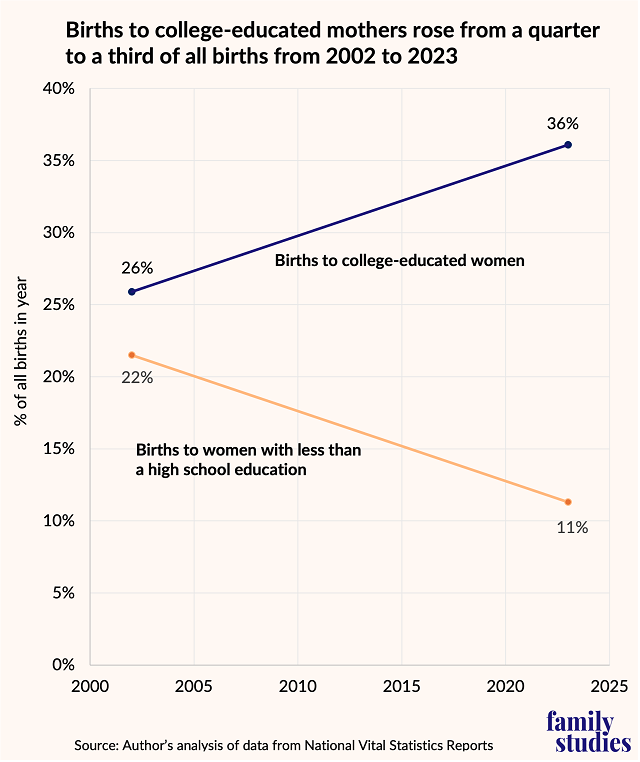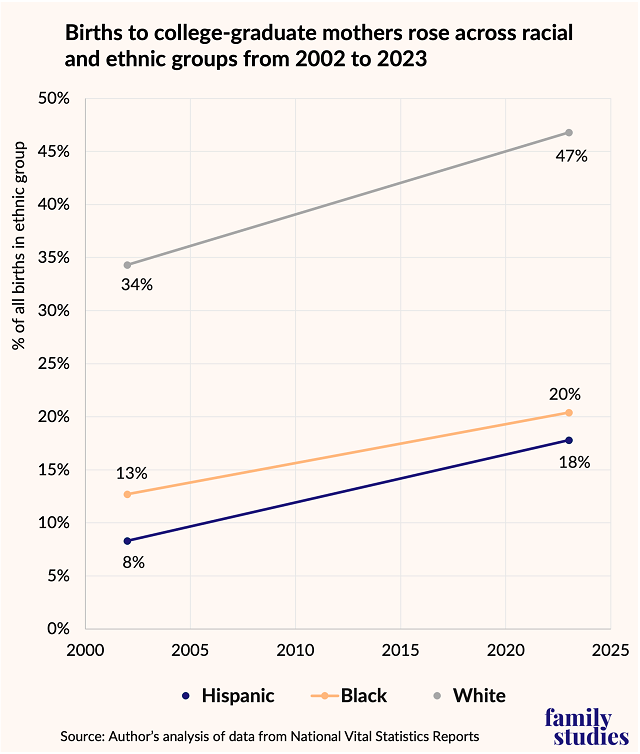Highlights
- Increases in births to college graduates occurred across racial and ethnic groups, with the largest proportional jump occurring among Hispanic infants. Post This
- Having a college-educated mother benefits a child in terms of family stability, freedom from want, and academic achievement. Post This
- The proportion of babies born to college-educated women increased by nearly 40% from 2002 to 2023. Meanwhile, the proportion born to women with less than a high-school education declined nearly 50%. Post This
Amid doubts about the wisdom of bringing children into a world filled with wars, environmental degradation, and ideological divisions, it is a gratifying to be able to share some good news about children’s prospects in America.
My analysis of birth certificate data shows that the proportion of babies born to college-educated women increased by nearly 40% over the two decades from 2002 to 2023. It rose from one-quarter to more than a third of all U.S. births. Over the same time span, the proportion born to women with less than a high-school education dropped by nearly 50%, from 22% in 2002 to 11% in 2023.

More Hispanic & Black Babies With College-Educated Moms
Increases in births to college graduates occurred across racial and ethnic groups, with the largest proportional jump—114%—occurring among Hispanic infants. As shown below, only 8% of Hispanic babies had a college-graduate mother in 2002, compared to 18% in 2023. Among Black infants, there was a proportional gain of 61%, from 13% of Black babies having college-graduate mothers in 2002 to 20% in 2023.
Among white infants, the proportional gain was 36%, from a third of white infants having college-educated mothers in 2002 to nearly half— 47%—having them in 2023.

The proportion of births to women with bachelor’s degrees varied widely across other racial and ethnic groups. In 2023, it was highest among Asian American newborns (69%) and lowest among American Indian and Alaska Native (12%) and Native Hawaiian and Pacific Islander infants (10%).1 There was also variation across subgroups of Hispanic newborns, with Cuban infants having the highest percentage (33%) and Mexican infants, the lowest (15%).2
Contributing Social Trends
Several trends in education and childbearing contributed to the increase in births to college-educated women. Among them are:
- More U.S. women graduating from college. Between 1995 and 2024, the proportion of U.S. women aged 25-34 with a bachelor’s degree grew from 25% to 47%.
- Fewer births to teenagers (who are unlikely to be college graduates). Between 2002 and 2023, the proportion of U.S. births to women under age 20 fell by 63%, from 11% to 4% of all births.3
- More births to older mothers, who are more likely to be college educated. Between 2002 and 2023, the proportion of U.S. births to women aged 35-39 grew by 49%, from 11% to 17% of all births.4
- More births to women who immigrated to the U.S. from Asian and European countries, who are more likely to be college educated. As noted above, 69% of infants born to Asian American mothers in 2023 had mothers with bachelor’s degrees or more.
Good News for Children
There are several reasons these developments are beneficial for American children and families. That’s because children born to college-graduate mothers have a:
- Greater likelihood of having married parents at birth and throughout their formative years: Infants born to mothers with bachelor’s degrees or more in 2023 were 1.6 to 1.8 times more likely to have married mothers than infants born to women who were only high school graduates.5
- Lower risk of growing up in poverty and welfare dependence: Infants born to mothers who were high school graduates only were 7.2 times more likely have had their deliveries paid for by Medicaid than infants born to mothers who were college graduates or more.6
- Better chance of doing well and going far in school: In 2019, high school seniors with college-graduate parents were twice as likely to be proficient readers as students with parents who were only high-school graduates, and three times more likely to be proficient in mathematics.7
Conclusion
Evidence from cross-sectional surveys indicates that having a college-educated mother has benefits for a child in terms of family stability, freedom from want, and academic achievement. There is less clearcut longitudinal evidence as to whether the gains in maternal education will translate into overall improvements in family well-being and student achievement.
Divorce rates have dropped in recent years but so have marriage and total fertility rates. Rates of births to unmarried women have remained stubbornly high. Child poverty rates have had a long-term downward trend between 1990 and 2023, going from 20.6% in 1990 to 13.7% in 2023, but with considerable fluctuations in between, related to overall economic conditions, changes in welfare policies, and the Covid 19 epidemic.
There has certainly been an upward trend in high school graduation rates in virtually all states and localities. But soaring rates of diploma awarding have not been accompanied by gains in standardized test scores.
It remains to be seen whether the increase in births to college graduate mothers will lead to further improvements in marital stability, family economic well-being, and student achievement in the years to come. But for now, the increase seems like a welcome piece of good news amid concerns about the “birth dearth” and the “anxious generation.”
Nicholas Zill is a research psychologist and a Senior Fellow of the Institute for Family Studies. He directed the National Survey of Children, a longitudinal study that produced widely cited findings on children’s life experiences and adjustment following parental divorce.
1. National Vital Statistics Reports, Vol. 74, No. 1, March 18, 2025, Table 11.
2. National Vital Statistics Reports, Vol. 74, No. 1, March 18, 2025, Table 12.
3. National Vital Statistics Reports, Vol. 52, No.10, December 17, 2003, Table 21 & Vol. 74, No. 1, March 16, 2025, Table 11.
4. Ibid.
5. Author’s analysis of micro data file of 2023 birth certificate data from U.S. Centers for Disease Control.
6. Ibid.
7. See Nation's Report Card at: www.nationsreportcard.gov/mathematics/results/groups/ and parallel website for reading.













